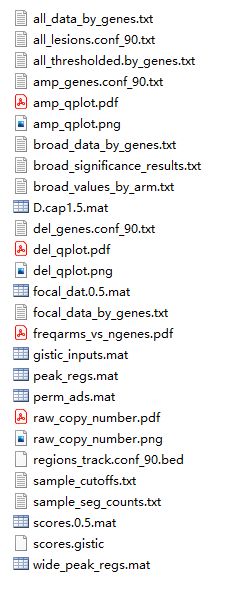TCGA的拷贝数变异CNV可视化
大家看文献时可能经常遇到各种CNV gistic score的可视化,都很好看,但是不知道怎么画出来的:
GISTIC2会自动出一些结果,但是并不好看,而且扩增和删失是分开的:
网络上也没找到怎么画,只能自己操作一下了!
数据准备
首先你要获得GISTIC2.0的输出结果,这是一个linux软件,得到的结果如下:

至于这个软件怎么用,大家可以去百度一下~教程非常多,不过对于小白还是蛮复杂的!
使用maftools画图
maftools这个包可以做一些拷贝数变异的可视化,比如上面展示的那种图,但是画出来也不好看,也没有什么自定义选项,很明显是达不到各位的审美水平的。
## 使用maftools分析
library(maftools)
all.lesions <- "./TCGA_COAD_results/all_lesions.conf_90.txt"
amp.genes <- "./TCGA_COAD_results/amp_genes.conf_90.txt"
del.genes <- "./TCGA_COAD_results/del_genes.conf_90.txt"
scores.gis <- "./TCGA_COAD_results/scores.gistic"
coad.gistic = readGistic(gisticAllLesionsFile = all.lesions,
gisticAmpGenesFile = amp.genes,
gisticDelGenesFile = del.genes,
gisticScoresFile = scores.gis, isTCGA = TRUE)
## -Processing Gistic files..
## --Processing amp_genes.conf_90.txt
## --Processing del_genes.conf_90.txt
## --Processing scores.gistic
## --Summarizing by samples
gisticChromPlot(gistic = coad.gistic
,markBands = "all"
,ref.build = "hg38"
)
# gisticBubblePlot(gistic = coad.gistic)
这个图和文献里看到的还是差距很大的!下面我们学习下用ggplot2画图!
ggplot2画图
基础知识
首先要了解这个图是什么意思,横坐标是染色体(或基因组?),纵坐标是G-Score,红色表示扩增,蓝色表示删失,如果要用ggplot2画这个图,那我们也要有这个数据才行!
在GISTIC2.0的输出结果中,有一个scores.gistic的文件,我们可以用VScode打开看看:

看看它的列名,真是太巧了,竟然和我们需要的数据非常相似,有gistic score,也有染色体位置,还有扩增或者删失!
但是这个文件理解还是需要一些基础知识的,说实话在学习画这个图之前我是不知道这些知识的,因为从来没用到过,所以也不会专门去学。。。
首先这个染色体位置,就Start/End这两列,指的是在每一条染色体上的位置,第一条染色体上有3302046-3371973这个位置,那第2条,第3条等等都有这个位置区间,它并不是从0开始,一直过去的!
那我们画图是需要从0开始的,所以我们就需要知道每一条染色体长度是多少,然后分别计算从0开始的位置坐标是多少!
真的是让人头大,这个又是我的知识盲区了!所以我去了bioconductor找它的一些文档看看,因为我知道里面是有很多基因组的注释包这些东西的。通过半天的学习,我知道了BSgenome这个东西,还知道了人类的全基因组序列包BSgenome.Hsapiens.UCSC.hg38,这里面就有各个基因组的位置和长度信息。
然后再继续学习下就知道BSgenome也是一个对象,可以通过特定函数提取信息。
OK,下面就开始提取信息了!
rm(list = ls())
library(BSgenome.Hsapiens.UCSC.hg38) # 加载R包
## Loading required package: BSgenome
## Loading required package: BiocGenerics
##
## Attaching package: 'BiocGenerics'
## The following objects are masked from 'package:stats':
##
## IQR, mad, sd, var, xtabs
## The following objects are masked from 'package:base':
##
## anyDuplicated, append, as.data.frame, basename, cbind, colnames,
## dirname, do.call, duplicated, eval, evalq, Filter, Find, get, grep,
## grepl, intersect, is.unsorted, lapply, Map, mapply, match, mget,
## order, paste, pmax, pmax.int, pmin, pmin.int, Position, rank,
## rbind, Reduce, rownames, sapply, setdiff, sort, table, tapply,
## union, unique, unsplit, which.max, which.min
## Loading required package: S4Vectors
## Loading required package: stats4
##
## Attaching package: 'S4Vectors'
## The following objects are masked from 'package:base':
##
## expand.grid, I, unname
## Loading required package: IRanges
##
## Attaching package: 'IRanges'
## The following object is masked from 'package:grDevices':
##
## windows
## Loading required package: GenomeInfoDb
## Loading required package: GenomicRanges
## Loading required package: Biostrings
## Loading required package: XVector
##
## Attaching package: 'Biostrings'
## The following object is masked from 'package:base':
##
## strsplit
## Loading required package: rtracklayer
提取染色体名字及长度:
df <- data.frame(chromName = seqnames(BSgenome.Hsapiens.UCSC.hg38), # 染色体名字
chromlength = seqlengths(BSgenome.Hsapiens.UCSC.hg38)# 每条染色体长度
)
df$chromNum <- 1:length(df$chromName) # 染色体名字纯数字版,为了和scores.gistic里面的对应
# 我们用的原始CNV文件是没有性染色体信息的
df <- df[1:22,] # 只要前22条染色体信息
df
## chromName chromlength chromNum
## chr1 chr1 248956422 1
## chr2 chr2 242193529 2
## chr3 chr3 198295559 3
## chr4 chr4 190214555 4
## chr5 chr5 181538259 5
## chr6 chr6 170805979 6
## chr7 chr7 159345973 7
## chr8 chr8 145138636 8
## chr9 chr9 138394717 9
## chr10 chr10 133797422 10
## chr11 chr11 135086622 11
## chr12 chr12 133275309 12
## chr13 chr13 114364328 13
## chr14 chr14 107043718 14
## chr15 chr15 101991189 15
## chr16 chr16 90338345 16
## chr17 chr17 83257441 17
## chr18 chr18 80373285 18
## chr19 chr19 58617616 19
## chr20 chr20 64444167 20
## chr21 chr21 46709983 21
## chr22 chr22 50818468 22
str(df)
## 'data.frame': 22 obs. of 3 variables:
## $ chromName : chr "chr1" "chr2" "chr3" "chr4" ...
## $ chromlength: int 248956422 242193529 198295559 190214555 181538259 170805979 159345973 145138636 138394717 133797422 ...
## $ chromNum : int 1 2 3 4 5 6 7 8 9 10 ...
然后就是计算从0开始的每条染色体位置坐标,就是简单的线段长度加减法,不过对于我这种好久不搞数学的人来说也是很费脑子的!
在scores.gistic这个文件里,第一条染色体位置是从0开始的,所以不用怎么改,但是第2条染色体的Start的坐标,应该是再加上第一条染色体的长度才是我们需要的,以此类推,不断相加!
所以我们先计算下每条染色体从0开始的起始坐标是多少!第一条染色体起始位置就是0,第二条起始位置是第一条长度的位置,第3条是前两条长度的位置,以此类推!
# 小发现,在用cumsum前要把int变成numeric
df$chromlengthCumsum <- cumsum(as.numeric(df$chromlength)) # 染色体累加长度
# 得到每条染色体从0开始的起始坐标
df$chormStartPosFrom0 <- c(0,df$chromlengthCumsum[-nrow(df)])
# 计算每条染色体中间位置坐标,用来最后加文字
tmp_middle <- diff(c(0,df$chromlengthCumsum)) / 2
df$chromMidelePosFrom0 <- df$chormStartPosFrom0 + tmp_middle
df
## chromName chromlength chromNum chromlengthCumsum chormStartPosFrom0
## chr1 chr1 248956422 1 248956422 0
## chr2 chr2 242193529 2 491149951 248956422
## chr3 chr3 198295559 3 689445510 491149951
## chr4 chr4 190214555 4 879660065 689445510
## chr5 chr5 181538259 5 1061198324 879660065
## chr6 chr6 170805979 6 1232004303 1061198324
## chr7 chr7 159345973 7 1391350276 1232004303
## chr8 chr8 145138636 8 1536488912 1391350276
## chr9 chr9 138394717 9 1674883629 1536488912
## chr10 chr10 133797422 10 1808681051 1674883629
## chr11 chr11 135086622 11 1943767673 1808681051
## chr12 chr12 133275309 12 2077042982 1943767673
## chr13 chr13 114364328 13 2191407310 2077042982
## chr14 chr14 107043718 14 2298451028 2191407310
## chr15 chr15 101991189 15 2400442217 2298451028
## chr16 chr16 90338345 16 2490780562 2400442217
## chr17 chr17 83257441 17 2574038003 2490780562
## chr18 chr18 80373285 18 2654411288 2574038003
## chr19 chr19 58617616 19 2713028904 2654411288
## chr20 chr20 64444167 20 2777473071 2713028904
## chr21 chr21 46709983 21 2824183054 2777473071
## chr22 chr22 50818468 22 2875001522 2824183054
## chromMidelePosFrom0
## chr1 124478211
## chr2 370053187
## chr3 590297731
## chr4 784552788
## chr5 970429195
## chr6 1146601314
## chr7 1311677290
## chr8 1463919594
## chr9 1605686271
## chr10 1741782340
## chr11 1876224362
## chr12 2010405328
## chr13 2134225146
## chr14 2244929169
## chr15 2349446623
## chr16 2445611390
## chr17 2532409283
## chr18 2614224646
## chr19 2683720096
## chr20 2745250988
## chr21 2800828063
## chr22 2849592288
这样我们需要的信息基本都有了,接下来就可以读取文件进行操作了!
# 如果你不知道用哪个函数读取,多试几次就知道了!
scores <- read.table("./TCGA_COAD_results/scores.gistic",sep="\t",header=T,stringsAsFactors = F)
head(scores)
## Type Chromosome Start End X.log10.q.value. G.score average.amplitude
## 1 Amp 1 3302046 3371973 0 0.021837 0.339205
## 2 Amp 1 3375059 3380822 0 0.021099 0.354653
## 3 Amp 1 3381074 3449929 0 0.020520 0.368893
## 4 Amp 1 3451503 3503571 0 0.022561 0.392242
## 5 Amp 1 3505022 4071958 0 0.022036 0.376773
## 6 Amp 1 4072066 4090117 0 0.022599 0.374114
## frequency
## 1 0.036810
## 2 0.036810
## 3 0.034765
## 4 0.034765
## 5 0.032720
## 6 0.032720
每一个G.score都对应一个坐标,这样才能画图,但其实每一个Amp或者Del是一个区间,为了方便,我们就用起始坐标代替了,当然你也可以用中点、结束点表示。
chromID <- scores$Chromosome
scores$StartPos <- scores$Start + df$chormStartPosFrom0[chromID]
scores$EndPos <- scores$End + df$chormStartPosFrom0[chromID]
我们得到的G.score都是正数,需要把Del的G.score变成负数。
range(scores$G.score)
## [1] 0.000000 0.564793
scores[scores$Type == "Del", "G.score"] <- scores[scores$Type == "Del", "G.score"] * -1
range(scores$G.score)
## [1] -0.564793 0.280607
真的是很复杂!有没有大佬知道简单点的方法啊,求告知!
画图
library(ggplot2)
library(ggsci)
ggplot(scores, aes(StartPos, G.score))+
geom_area(aes(group=Type, fill=factor(Type,levels = c("Del","Amp"))))+
scale_fill_lancet(guide=guide_legend(reverse = T))+
geom_vline(data = df ,mapping=aes(xintercept=chromlengthCumsum),linetype=2)+
geom_text(data = df,aes(x=chromMidelePosFrom0,y=0.2,label=chromName))+
scale_x_continuous(expand = c(0,-1000),limits = c(0,2.9e9))+
ylim(-0.3,0.3)+
theme_minimal()
文字有重叠,我们增加一点错落感。
df$ypos <- rep(c(0.2,0.25),11)
ggplot(scores, aes(StartPos, G.score))+
geom_area(aes(group=Type, fill=factor(Type,levels = c("Del","Amp"))))+
scale_fill_lancet(guide=guide_legend(reverse = T),name="Type")+
geom_vline(data = df ,mapping=aes(xintercept=chromlengthCumsum),linetype=2)+
geom_text(data = df,aes(x=chromMidelePosFrom0,y=ypos,label=chromName))+
scale_x_continuous(expand = c(0,-1000),limits = c(0,2.9e9),name = NULL,labels = NULL)+
ylim(-0.3,0.3)+
theme_minimal()+
theme(legend.position = "top",
axis.text.y = element_text(color = "black",size = 14),
axis.title.y = element_text(color = "black",size = 16)
)
这就成了!
同理可画frequency,这里就不演示了!
画图3分钟,准备数据3小时!
本次示例使用的数据是TCGA-COAD的Masked Copy Number Segment,经过GISTIC2.0软件得到的,大家完全可以自己搞出来。
欢迎加入交流群交流讨论~





